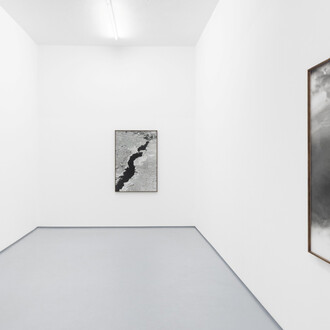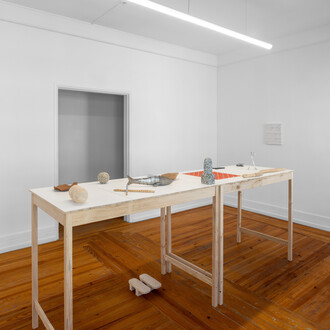Jahn und Jahn is pleased to present the first exhibition of the Swiss artist Heidi Bucher (1926–1993) in Portugal, featuring a significant group of works across the gallery’s seven rooms, from sculpture to drawing.
Throughout her life, Heidi Bucher (1926-1993) produced a vast oeuvre focusing on the body and its relationship to architecture, experiential space and hapticity from a feminist, critical and activistic perspective.
Although her trajectory started in 1956, it was after her stay in New York in the early 1960s and then in her native Switzerland and in Los Angeles during the following decade, that Heidi Bucher produced an entire oeuvre which, in a certain sense, built an anthropology of sculpture as well as an aesthetic that addresses both individual sensibility and the sharing that generates a notion of collectiveness.
Hedi Bucher belongs fully to the second avantgardes and their more prominent questions – the importance of process, the fluidity between the production of devices, their performative use and the political awareness of the notions of community and difference. Indeed, she opened a path that begins with the construction of dwellings for the body and then goes on to focus on the use of latex and the moulding of spaces and bodies.
The start of her trajectory was marked by the creation of cocoons, ‘soft’, ductile sculptures that served simultaneously as individual shelters and wearable sculptural pieces, sometimes made in collaboration with her husband, sculptor Carl Bucher. A first insight ensuing from this transformation of sculpture (traditionally structural and rigid) into an object that envelops, protects and metamorphizes the body, is that for Bucher the core of the sculptural work is not the object, but its inhabitability either by the artist or by another agent, which leads her to produce a transitive art eminently geared towards usability. The second insight is that the notion of mould, that which precedes sculpture (like Bruce Nauman was doing at the time, albeit resorting to different processes), allows for a gradual orientation of the object towards an anthropology of the body and of sculpture itself as memory.
From the early 1970s onwards, already in Zurich (in a studio that had, interestingly, been a former butcher’s shop), Heidi Bucher created a series of works called ‘soft’ sculptures which she titled “Einbalsamierungen” (Embalmings), a complex taxidermy resorting to textiles, fragments of clothing that had belonged to her family (an aspect that would prove vital in the future), shells and natural found elements, to produce dubious metaphorical bodies.
In 1976, as she followed along this path Bucher began her first projects using latex to mould architectural elements and build drapery-like fluid versions of latex moulded on architectural spaces. For the first of these projects, she moulded the door of her Zurich studio and called it Borg (Die türe zum borg, 1976) [Borg (Door to the Borg) 1976]; the symbolic access to a protected space of retreat.
The most significant space moulding projects using latex was the creation of a mould of her family home (walls and floor), which began in 1972/3. The first space chosen by the artist in that home, which marked her bourgeois origin, was the gentlemen’s study, the Herrenzimmer*, 1978-82, a piece signalling her distance from patriarchal family structure and mapping the social and power relationships she wanted to expose.
The discovery of this process, which is related to developments in the work of other coeval artists such Eva Hesse, Lynda Banglis or Judy Chicago, gradually defined a long path towards the creation of symbolic spaces that also displayed sensitivity and aesthetical sophistication. This symbolic character is also apparent in her choice of Ludwig Binswanger’s office at the clinic by the shore of Lake Constance, where so many figures were received, from Sigmund Freud to German historian Aby Warburg, who was an inpatient there in the 1920s.
Bucher’s complex methodology in creating these liquid moulds is akin to taking the skin off the architectural structure; a skin created and removed by the artist – a skinning of the space. The result is a negative impression of the architectural space, as Rachel Whiteread would later do, albeit ductile and suspended. This process produces a skin that retains the building’s memory and, in the installation process, creates a fragile architecture doomed to collapse. One could say that Heidi Bucher’s oeuvre moved towards the fibrillation of the experience of space by charging her fragile latex architecture with an intensity that tells the phantasmatic narratives of the moulded spaces themselves. The fact that the artist used these latex ‘skins’ in performances only confirms the idea that her focus was always the relationship between the body and the space it secretes by seeking to find pathways between the individual haptic experience and the understanding of historical processes of domination and control that had never been metaphorized but always alluded to.
The skin of Heidi Bucher’s works is, therefore, the haptic form of memory recollection which, in the skinning process, is materialized in its full symbolic potency.
(Text by Delfim Sardo)














